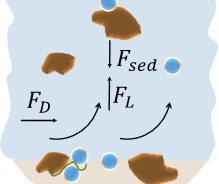Sediment resuspension in the NanoFASE model
The resuspension (remobilisation) of sediments in rivers and estuaries can transfer attached nanomaterials from bed sediments into watercourses, thus dampening the effect that sediment deposition has in enabling bed sediments to act as a sink for nanomaterials.
The amount of sediment resuspended on each time step is directly proportional to the energy supplied to it by the flowing river, and thus the stream power per unit area of the bed \(\omega\) \(W[m^2]\) can be used in its calculation. For a river or estuary reach of length \(l f_{\text{m}}\) (where \(l\) is the linear length and \( f_m\) is a factor to account for meandering), width \(W[m]\) and assuming a rectangular bed with bed slope \(s\) [m/m], small enough that \(\sin (s) \approx s\), the stream power per unit area is given by:
| \(\omega = \frac{\Omega}{Wlf_{\text{m}}} = \frac{\rho_{\text{w}}gQs}{W}\) | where \(\omega\) is the power provided by the stream [W],\( ρ_w\) is the density of water [kg/m3], \(g\) is acceleration due to gravity [m/s2] and \(Q\) is the flow of the reach [m3/s] |
The maximum resuspendable grain size [m],
\(d_{\text{max}} = 9.9941 (v^*)^{2.5208}\),
is calculated from the shear velocity
\(v^* = \sqrt{\alpha g D s}\),
where \(D\) is the reach depth [m] and α is a calibration parameter. Resuspension can be calculated for each sediment size class separately, necessitating that we introduce a parameter describing the proportion of each sediment size class that is resuspendable:
|
\(m_{\text{prop},n} = \begin{cases} \frac{d_{\text{max}} – d_{\text{low},n}}{d_{\text{upp},n} – d_{\text{low},n}} & \mbox{if } d_{\text{low},n} \leq d_{\text{max}} \leq d_{\text{upp},n} \\ 0 & \mbox{if } d_{\text{max}} < d_{\text{low},n} \\ 1 & \mbox{if } d_{\text{max}} > d_{\text{upp},n} \end{cases}\) |
where \(d_{low,n}\) and \(d_{upp,n}\) are the lower and upper bounds of each sediment size (m). |
Execution
Finally, we can formulate the resuspension flux [kg/s] for the entire reach (with bed sediment area \(Lf_{m}W\)) as:
| \(\mathbf{j}_{\text{SPM,res}} = \beta l f_{\text{m}} W \mathbf{M}_{\text{bed}} \mathbf{m}_{\text{prop}} \omega f_{\text{fr}}\) |
where β is a calibration parameter [s2/kg], and M_bed, m_prop and j_(SPM,res) are arrays of bed sediment mass per unit area [kg/m2], resuspendable proportion and resuspended sediment flux [kg/s], respectively, across the different size classes. \(f_fr\) is a friction factor, defined as the ratio of the actual hydraulic radius (a rectangular channel) to the maximum hydraulic radio of a channel with the same width (a pipe): \(f_{\text{fr}} = 4D/(W+2D) \) |
Calibration
The NanoFASE WSO model generally aims to require the least possible calibration, and thus be applicable to the widest range of geographical regions. The resuspension process is one of the few that require calibration, namely of the two parameters α and β. If available, observed suspended sediment concentrations should be used to perform this calibration.
Used in
Read more |
Read also |
|
Consult the NanoFASE Library to see abstracts of these deliverable reports: |
Lazar, A. N., Butterfield, D., Futter, M. N., Rankinen, K., Thouvenot-Korppoo, M., Jarritt, N., Whitehead, P. G. (2010). An assessment of the fine sediment dynamics in an upland river system: INCA-Sed modifications and implications for fisheries. Science of The Total Environment, 408(12), 2555-2566. doi: https://doi.org/10.1016/j.scitotenv.2010.02.030 |
Contact
 Sam Harrison
Sam Harrison
Centre for Ecology and Hydrology (CEH)

